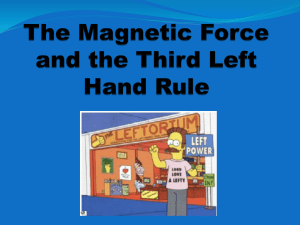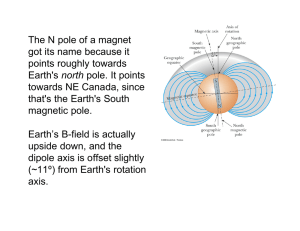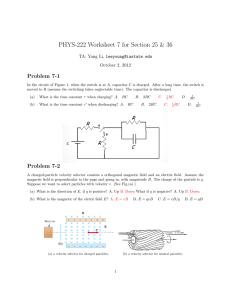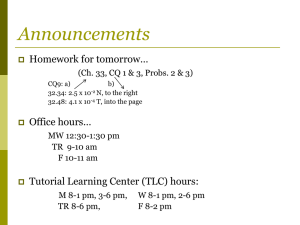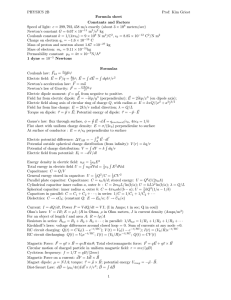The N pole of a magnet got its name because it north
advertisement
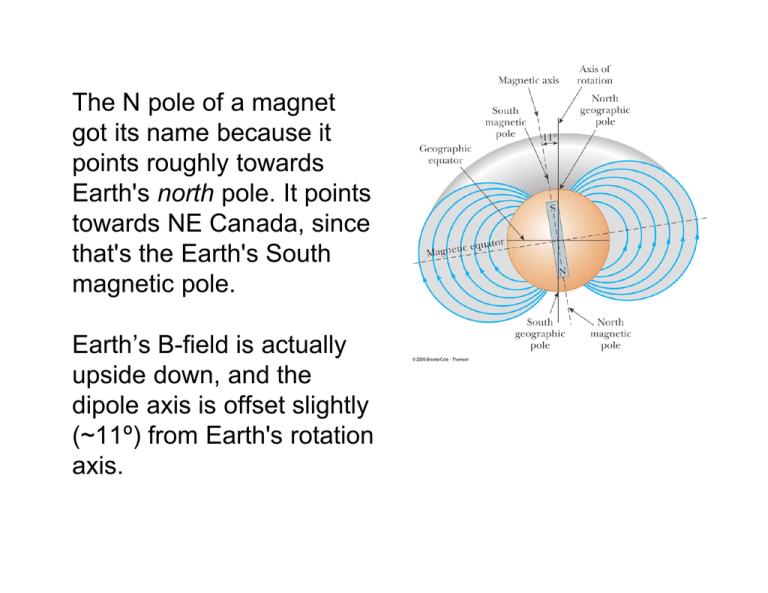
The N pole of a magnet got its name because it points roughly towards Earth's north pole. It points towards NE Canada, since that's the Earth's South magnetic pole. Earth’s B-field is actually upside down, and the dipole axis is offset slightly (~11º) from Earth's rotation axis. Earth's magnetic field has a vertical component at the surface: Points upwards in southern hemisphere. Points downwards in northern hemisphere. Parallel to surface at magnetic equator. Source: Current/ convection in hot Fe liquid core Basalt is expelled from volcanoes and cools, and the B-field becomes imprinted. Mid-Atlantic Ridge shows that B-field direction changes every ~0.1–1 Myr Mars Mars: No ‘global’ B-field like Earth’s (no internal dynamo?) Mars Global Surveyor (JPL/NASA) Mars Global Surveyor’s magnetometers: very strong crustal fields: Older crust is magnetized much more strongly than newer crust Indicates that very strong global magnetic fields existed, but only before ~4 billion yr ago (from comicvine.com) Mars Meteor impacts: crust melts and reforms; any imprinted magnetism is lost Mars Global Surveyor (JPL/NASA) Mars’ surface area/ volume ratio (prop.to 4πr2 / (4π/3)r3 prop.to 1/r) is larger than Earth’s: lost interior heat & dynamo mechanism faster Moon: also evidence for a B-field that was stronger in the past (from Lunar Prospector mission) (from comicvine.com) Units of B-fields Tesla [SI] and Gauss [cgs] 1 Tesla = 104 Wb N N Gauss. T = = = 2 m C ⋅ (m / s) A ⋅ m Typical B-field strengths: Earth's B-field at surface: 0.5x10-4 T = 0.5 G Refrigerator magnet: ~0.005 T Bar magnets: 0.01 T MRI machine: 1-5 T Laboratory magnet: 5 T Superconducting magnet: 20-30 T Magnetic field produces a force on a moving charge A charge q moving with velocity v in a magnetic field B experiences a force F with magnitude: F = q v B sin(θ) θ is the smallest angle between the vectors v & B F is perpendicular to BOTH v and B F = qvBsin(θ) Magnitude of Force depends on both v and B: If v=0 or B=0, then F=0 Force depends on angle θ: If B || v, F = 0 Force is max. when v and B are perpendicular Because F is perp. to v, magnetic forces cannot change a particle's speed, just its direction of motion. Right-hand rule (my version) Thumb = v (e.g., hitchhiking) Fingers = B (like my fingers are bar magnets) Out of Palm = Magnetic Force B F v Example: A proton is moving at 1×104 m/s from left to right in a magnetic field of 0.4 T that's in the upward direction (in the plane of the page). Find the magnitude of the force vector. Find the direction. What would the force be if the particle was an e–? F = B * q * v * sinθ = 0.4T * 1.6×10-19 C * 104 m/s * sin90º = 6.4 × 10-16 N Direction of force: out of the page towards you. For e–: Magnitude of force is same, but in the opposite direction. B-field notation out of page: • • • • • • • • • • • • • • • • • • • • • • • • • • • • • • • • • • • • • • • • into page: ×××××××× ×××××××× ×××××××× ×××××××× ×××××××× think of the points/tails of arrows Velocity Selector Perpendicular E and B fields can be used to select charged particles having a specific velocity FB = evB (downward for e–) e- v FE = eE (upward for e–) When FB=FE, forces cancel: evB=eE v = E/B: electron with this velocity will be undeflected ×××××××× ×××××××× ×××××××× ×××××××× ×××××××× E: downward B: into page Velocity Selector Example: A velocity selector has perpendicular electric and magnetic field of E= 1000 V/m and B= 0.3 T. Find the velocity of the electrons that pass through undeflected. What would happen to faster electrons? Slower? v=E/B = 1000V/m / 0.3 T = 3.3×104 m/s e- v ×××××××× ×××××××× ×××××××× ×××××××× ×××××××× E: downward B: into page Motion of a charged particle in a magnetic field F is in a plane perpendicular to B. Particle’s path remains in plane perpendicular to B. mv 2 F = qvB = r mv r= qB A proton with velocity v=1×106 m/s is in a uniform B-field of 0.2 T. Find r: r = mV / qB = (1.67×10-27 kg * 1×106 m/s) / (1.6×10-19 C * 0.2 T) 5.2 cm = Mass Spectrometers mv r= qB 4. Ions with the same charge become separated by mass onto photographic plate: compute charge/mass ratio 3. Molecular ions injected into B-field at velocity v 1. A sample is ionized (impacting with a e– beam). 2. Positive ions are accelerated by an E-field through veloc selector Example: A mass spectrometer has a velocity selector at its inlet such that only q=+1 ions with v = 1×105 m/s are permitted inside the mass spectrometer, where the B-field is 0.2 T. A mixture of gas containing CO2+ is injected. But some of the CO2 contains Carbon14. What radii are 12CO2+ and 14CO2+ rotated through, and what is their separation on the photographic plate? Reminder: mass is for whole molecule. FB works on the singular positive charge only. Assume mp = mn for simplicity; ignore masses of electrons sicne they’re 1800x less massive than protons/neutrons Mass (12CO2+) = (12+16+16)*1.67×10-27kg = 44 * 1.67×10-27kg = 73.5×10-27 kg Mass (14CO2+) = (14+16+16)*1.67×10-27kg = 46 * 1.67×10-27kg = 76.8×10-27 kg Reminder: mass is for whole molecule. FB works on the singular positive charge only. r(12CO2+) = mv/qB = (73.5×10-27 kg * 105 m/s) / (1.6×10-19C * 0.2T) = 23.0 cm r(14CO2+) = mv/qB = (76.8×10-27 kg * 105 m/s) / (1.6×10-19C * 0.2T) = 24.0 cm The diameters of the circles traced out will be 46.0 and 48.0 cm, respectively. The separation on the photographic plate will be 2.0 cm. Reminder: mass is for whole molecule. FB works on the singular positive charge only. When B and v are not exactly perpendicular: Motion || to B-field is unaffected. Motion perp. to B-field is circular. So a charge will follow a HELICAL path around field lines. Example: Solar Prominences: Charged particles in sun’s corona move in helices along B-field lines, emit light & map out those B-field lines Solar prominence viewed by SOHO: Solar prominence viewed by TRACE: Aurora Charged particles from solar wind or solar flares get caught in B-field lines in Earth's B-field, funneled to the poles apod.nasa.gov Appears as circle surrounding magnetic pole (NASA’s Polar Sat.) gsfc.nasa.gov
